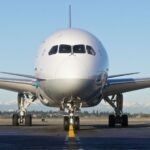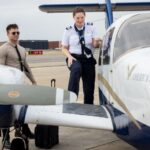By Steven Daun
There are countless times in aviation history and the development of a certified flight instructor course when friendship and a handshake formidably changed our industry. In fact, much of what we consider modern-day aviation wouldn’t exist today without these unique “handshakes”.
This is a story of friendship, ingenuity, and two very special men who forever changed how pilots learn to fly. This is the story of how American Flyers and Frasca Simulators revolutionized the certified flight instructor course. American Flyers as we know it today actually started out as two separate companies: American Flyers, founded in 1939 in Ft. Worth, TX by pilot Reid Pigman, and Aviation Training Enterprises (A.T.E.), founded in 1946 by former Army Air Corps instrument instructor Monty Montgomery. A.T.E. purchased American Flyers in 1980, keeping its fine name for the combined companies.
In the mid-1940s, general aviation in the United States was in its infancy; even the airlines were a budding industry. Things were different in the military, as it was far ahead of its civilian counterpart and already using flight simulators to train pilots in a range of aircraft and missions. After WWII,however, the intense military flight training machine was winding down, and two military simulator instructors had been honorably discharged from the army and were ready to begin new chapters in their lives.
Monty Montgomery promptly created A.T.E. He purchased military surplus simulators and installed them in a second-floor office over a butcher shop near Chicago’s Midway Airport. The simulators, ironically, were wooden, motion Link Trainers that relied on organ bellows and air compressors to work. It wasn’t long before several airlines came calling, asking for simulator instrument training for their line pilots; thus began the use of flight simulators in airline training. However, the maintenance requirements for these simulators were tremendous, costly, and required highly-trained technicians to keep them operable.
A hundred miles south in central Illinois, Rudy Frasca was starting his simulator business. His prototype used WWII surplus link parts, but was housed in Frasca’s own cockpit and used Frasca’s own mechanical mechanisms to solve the simulation equations. After months of planning and designing, he paid a visit to his old friend Monty. The two discussed the needs of the airlines and the changing trend in aviation towards instrument training. Rudy demonstrated the prototype to Monty and Monty committed to funding and purchasing the first Frasca Model 100 simulator.
At this time, Monty was not a pilot and Rudy, who soloed at the age of 14, earned his pilot license in 1945. Ironically, Monty wasn’t an aviation enthusiast. In fact, he didn’t care much for flying at all, but he eventually received his commercial pilot certificate and flight instructor ratings through a certified flight instructor course because he got tired of telling students that he wasn’t a commercial pilot.
Rudy, on the other hand, not only embraced simulation, he went on to become one of the biggest collectors of rare aircrafts and warbirds in the world. Rudy continued to fly these airplanes well into his 80s.
Over the years, family and employees for both companies had the benefit of sitting down with the pair aviation pioneers and hearing their stories of how commercial and general aviation began. I had the privilege of participating in several of these sessions, and it was very special to hear in their own words how both companies began and grew because of their friendship and cooperation. We heard the stories behind the invention of the modern-day instrument system, the development of approach procedures, and the various laws of learning.
When people ask us what sets us apart from other schools, we have a simple answer: all schools have instructors, use airplanes, and many use simulators, but very few schools have an innate culture instilled and honed over 75 years of discovery, proficiency, quality, and commitment to education and safety. This is the legacy that is ingrained into all of the employees and instructors at American Flyers and at Frasca International who work with the certified flight instructor course. It may sound cliche, but you feel it when you walk into their offices. You see it on the employee’s faces. You recognize the quality of education when you complete your training and are on your own in the air.
Similar to a racehorse, the genetic code has been improved on as it was passed down to the generations.










